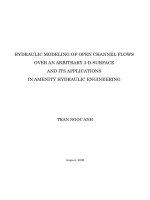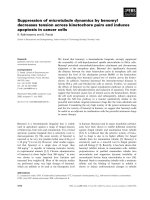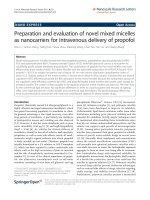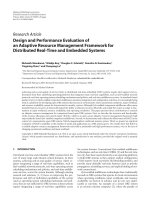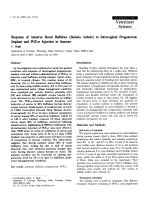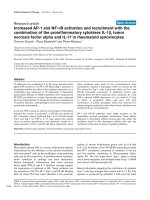Evaluation of structurally different benzimidazoles as priming agents, plant defence activators and growth enhancers in wheat
Bạn đang xem bản rút gọn của tài liệu. Xem và tải ngay bản đầy đủ của tài liệu tại đây (717.21 KB, 11 trang )
(2019) 13:29
Hameed et al. BMC Chemistry
/>
RESEARCH ARTICLE
BMC Chemistry
Open Access
Evaluation of structurally different
benzimidazoles as priming agents, plant
defence activators and growth enhancers
in wheat
Arruje Hameed1, Amjad Hameed2, Tahir Farooq3*, Razia Noreen1, Sadia Javed1, Shaheera Batool4,
Ashfaq Ahmad3, Tahsin Gulzar3 and Matloob Ahmad5
Abstract
Priming is a valuable, facile and well-established technique used to enhance seed quality to achieve rapid germination, establishment of stress resistance and improvement of crop yields. Different natural and synthetic priming
agents have been used for better crop performance and abiotic stress management. In this study, four different
benzimidazoles were selected as priming agents and their comparative effects were evaluated on different biochemical attributes including total soluble protein, total oxidant status, MDA contents, antioxidant enzymes (SOD, POD) and
hydrolytic enzymes (protease, estrases) compared to control. Treatments with 2-thio-1-H-benzimidazole reduced total
soluble proteins and increased total oxidant status significantly but no considerable effect was observed on other
parameters. Priming with 2-(4-chlorophenyl)-1-H-benzimidazole considerably increased the total oxidant status and a
little improvement was observed in total soluble proteins. Seeds primed with 1-H-benzimidazole showed a noticeable
decrease in the protease activity while all other priming treatments were unable to induce any detectable change
compared to control. The treatment with 2-(4-methoxyphenyl)-1-H-benzimidazole induced maximum reduction in
MDA contents and POD activity. Moreover, all benzimidazole priming treatments reduced mean germination time,
increased germination percentage and germination rate of wheat seeds.
Keywords: Seed priming, Antioxidants, Benzimidazole, Hydrolytic enzymes, Wheat
Introduction
Due to rising global population, it has been estimated
that the demand for wheat is going to be doubled in 2050
[1]. To satisfy these rising wheat demands, farmers are
supposed to boost crop yields by adopting new farming
strategies. In this context, enhanced seed qualities has
become priority requirements to achieve uniform and
rapid seedling emergence for better crop performance
and finally increased yield [2]. Seed quality is enhanced
by employing facile, easily practicable and well established treatment called priming [3]. As a result of priming
*Correspondence:
3
Department of Applied Chemistry, Government College University,
Faisalabad, Pakistan
Full list of author information is available at the end of the article
treatments, germination rate increases with the development of high level stress tolerance which enhances
crop yields [4]. In fact, priming induces pre-germinative
metabolism to various level in seeds depending upon
their species, physiology and morphology [5]. These
specific metabolic changes trigger ATP production, denovo synthesis of proteins and nucleic acids, activation of
antioxidant enzymes and DNA repair, accumulations of
phospholipids and sterols [6, 7]. The activation of these
cellular mechanisms protect genome integrity, ensure
rapid germination with fast seedling emergence thus help
to provide high crop yields [8].
Around the globe wheat is the major cereal crop fulfilling almost half of the protein requirements and feeds
at least one-third world population. Often wheat crop
productivity is limited by slow germination rate, reduced
© The Author(s) 2019. This article is distributed under the terms of the Creative Commons Attribution 4.0 International License
(http://creativecommons.org/licenses/by/4.0/), which permits unrestricted use, distribution, and reproduction in any medium,
provided you give appropriate credit to the original author(s) and the source, provide a link to the Creative Commons license,
and indicate if changes were made. The Creative Commons Public Domain Dedication waiver (http://creativecommons.org/
publicdomain/zero/1.0/) applies to the data made available in this article, unless otherwise stated.
Hameed et al. BMC Chemistry
(2019) 13:29
seedling vigor, slow growth and development rates under
normal and stress conditions [9]. Under such situations,
various natural and synthetic chemicals have been used
as priming agents for various crops including wheat.
Chemical priming offers effective opportunities for crop
stress managements as it induces significant tolerance
against a range of abiotic stresses [10]. On-farm priming
of wheat seeds with ascorbic acid, salicylic acid, auxins,
H2O2, polyethylene glycol, kinetin and G
A3 etc. has been
reported to improve aforementioned germination, seedling growth, non-enzymatic and enzymatic antioxidants
related attributes leading to high grain yield [3].
The benzimidazole and its derivatives are exceptional
structural motif of wide interest exhibiting a broad
spectrum of applications across a range of scientific
disciplines [11–13]. The benzimidazole nucleus with
varied substituents has proved as a privileged moiety
with diverse potential of clinical and biological activities including antiviral, antibacterial, anti-tumor, antihypertensive, anti-diabetic and anti-HIV etc. [14, 15].
Compounds incorporating benzimidazole have also been
used as agrochemicals with fungicidic and plant growth
regulating properties [16]. Further, they provide protection and insulate plants against various environmental
stresses [17]. Mangnucka et al. treated rye grains with
10 ppm of carbendazim and benomyl before they were
allowed to germinate for 5 days [18]. These benzimiazole-based fungicides greatly affected the biosynthesis of
resorcinol and fresh and dry biomass of seedlings under
thermal and light growth conditions. Seed treatments
with Ambiol®, a known benzimidazole-based antioxidant
increased germination, enhanced growth and improved
stress tolerance in seedlings of many species [19–21].
Tomato seed treatments with Ambiol induced positive
effects on germination, growth and seedling development
which were passed-on to next generation. Vital parameters like photosynthesis, leaf area, percent germination,
Fig. 1 Structurally different benzimidazoles selected as priming agents
Page 2 of 11
root mass and shoot mass were considerably improved in
parents as well as in progeny [22].
In this study four different benzimidazoles were
selected as wheat seed priming agents and their effects
on biochemical attributes were evaluated. The subsequent sections do explain the comparative effects of these
benzimidazoles on vital biochemical and germination
parameters.
Materials and methods
Chemistry
Following known benzimidazoles were selected as priming agents for wheat seeds (Fig. 1) [23].
Seed collection and priming
For this priming study, the spring wheat (Triticumaestivum L. cv. GLAXY-2013) seeds were obtained from
Wheat Section, Nuclear Institute of Agriculture and
Biology (NIAB), Faisalabad, Pakistan. Wheat seed priming was achieved by soaking them in aerated solutions of
four different benzimidazoles with 20 and 30 ppm concentrations for 8 h. Afterwards, they were washed and
dried under shade at 26 ± 2 °C until they gained original
weight. Separately, seeds were soaked in distilled water
for 8 h to achieve hydro-priming. Untreated or nonprimed seeds were used as control for comparison in biochemical analyses and germination studies.
Biochemical analysis and germination studies
Different biochemical parameters were analyzed in
primed, hydro-primed and non-primed wheat seeds to
evaluate the effects of benzimidazole priming treatments.
According to well-established methods for estimation
and extraction of enzymes and other biochemical parameters, hydro-primed, primed and non-primed seeds were
grounded using 50 mM potassium phosphate buffer
with pH 7.4. At 4 °C, the grounded material was put on
Hameed et al. BMC Chemistry
(2019) 13:29
Page 3 of 11
(20, 28, 44, 52, 68, 76, 92 and 100 h), starting on the first
day of imbibition, and terminated when maximum germination was achieved. Final germination percentage
was measured according to following formula (Fig. 2).
Mean germination time (MGT) was calculated as following [34],
centrifugation at 15,000×g for 20 min and the supernatant was used for quantification studies of different
enzymes. The method described by Bradford was followed for protein estimation in seed samples [24]. Total
oxidant status was determined by following the method
presented by Erel et al. [25]. This method estimates the
presence of oxidants which oxidize Fe+2 to
Fe+3. The
method presented by Giannopolitis and Ries was followed with little modification to determine superoxide
dismutase (SOD) activities [26]. The method initially
presented by Heath and Packer and then modified by
Dhindsa et al. and Zhang and Kirkham was used to determine malondialdehyde (MDA) contents [27–29]. The
method of Drapeau was followed for protease activity
determination [30]. The method developed by Chance
and Maehly was employed for the determination of peroxidase (POD) activities [31]. The enzyme activities were
expressed on seed weight basis. According to the methods of Van Asperen [32], the α-naphthyl acetate and
β-naphthyl acetate were used as substrates for the determination of α-esterases and β-esterases [33].
Germination potential of the primed and control wheat
seeds was estimated. To test seed germination and seedling vigor under osmotic stress, four replicates of 25 seeds
were germinated in 12 cm diameter petri dishes at 25 °C.
A seed was scored as germinated when coleoptile and
radicle lengths reached 2–3 mm. Counts of germinating
seeds were made twice a day at different time intervals
MGT =
Dn
n
Germination index (GI) was calculated as described in
the Association of official Seed Analysts (AOSA) and the
energy of germination was recorded according to a wellknown method [35, 36].
Statistical analysis
The recorded data was analyzed statistically by applying
descriptive statistics. The significance between means
was measured using Tucky’s test at 5% probability level
using XL-STAT. Values presented are mean ± SD with
different alphabets differ significantly from each other.
Results and discussions
Changes in the total soluble protein contents in nonprimed, hydro-primed and benzimidazole primed wheat
seeds were measured (Fig. 3). A noticeable improvement in the protein contents was observed in the seeds
primed with 30 ppm of both 1-H-benzimidazole and
2-(4-chlorophenyl)-1-H-benzimidazole. While priming with 20 ppm of 2-thio-1-H-benzimidazole reduced
total soluble proteins to some extent compared to control. However, all other treatments showed no apparent difference in protein contents compared to control.
It may be suggested that the priming with benzimidazoles did not interrupt the cellular pathways or related
Fig. 2 Calculation of % germination
Total soluble protein (mg/g seed
wt.)
600
500
b
a
400
b
a
b
b
d
c
b
bc
water
untreated
Hydropriming
Control
300
200
100
0
20 ppm
30 ppm
1-H-Benzimidazole
20 ppm
30 ppm
2-Thio-1-HBenzimidazole
20 ppm
30 ppm
20 ppm
30 ppm
2-(4-Chlorophenyl)-1-H- 2-(4-methoxyphenyl)-1Benzimidazole
H-Benzimidazole
Fig. 3 Effect of different seed priming treatments on total soluble protein contents in wheat seeds
Hameed et al. BMC Chemistry
(2019) 13:29
Page 4 of 11
fast germination rate during the first 24 h as shown in
(Fig. 14).
During this wheat seed priming study, the level of
lipid peroxidation in seeds was measured in terms of
MDA contents (Fig. 5) [42, 43]. Priming with 20 ppm
of 1-H-benzaimidazole, 2-(4-chlorophenyl)-1-H-benzimidazole and 2-(4-methoxyphenyl)-1-H-benzimidazole showed no observable difference in MDA contents
as compared to control. Whereas, all other treatments
showed a significant reduction in the MDA contents
as compared to control. The treatment with 30 ppm
2-(4-methoxyphenyl)-1-H-benzimidazole induced maximum reduction in MDA contents. The MDA contents
are considered as indicator of lipid peroxidation caused
by reactive oxygen species (ROS).
The ROS are toxic by-products of aerobic metabolism
and results in oxidative stress. The oxidative stress cases
destruction of biomolecules like lipid, proteins, DNA and
also inactivates antioxidant enzymes [44]. Reduction in
MDA level represents low levels of oxidative stress while
high levels of MDA suggest overproduction of fatal free
radicals [45, 46]. It may be concluded that seed priming
with 30 ppm 2-(4-methoxyphenyl)-1-H-benzimidazole
reduced ROS levels and oxidative stress in wheat. Wheat
seed priming with polyethylene glycol has been reported
to reduce MDA contents [47]. Recently, priming treatments with mercapto-triazoles also reduced MDA content in wheat seeds representing a reduction in oxidative
stress [48].
enzymes involved in the biosynthesis of proteins. Jafar
et al. reported an increase in total soluble proteins when
wheat seeds were primed with salicylicate, kinetin, CaCl2
and ascorbate [37]. Similarly, Bajwa et al. also reported
an increase in total soluble proteins when benzyl amino
purine was used as a priming agent for wheat seeds [38].
Effects of different benzimidazole seed priming treatments on total oxidant status in wheat seeds were evaluated (Fig. 4). Total oxidant status increased remarkably
in seeds primed with 20 ppm 2-thio-1-H-benzimidazole
and 30 ppm 2-(4-chlorophenyl)-1-H-benzimidazole as
compared to untreated control seeds. While a noticeable
decrease in total oxidant status was observed as a result
of 20 ppm 1-H-benzimidazole and hydro-priming. The
oxidants were long considered as damaging species for
germinating seeds. Recent studies have confirmed their
well-established functions in cell signalling, regulation
of gene expressions and mobilization of reserves during
seed germination [39]. In germinating seeds the metabolically active compartments like mitochondria (for
respiratory activities), plasma membrane (by NADPH
oxidase) glyoxysomes (for lipid catabolism), peroxisomes
(for purine catabolism) become main source of oxidants
production. Strong increase in respiratory activities with
enhanced production of oxidants are associated with
germination [40, 41]. The aforementioned benzimiazole
treatments which increased total oxidants significantly
might have accelerated the metabolic activities to boost
seed germination. It has also been confirmed from the
Total oxidant status (µM/g seed wt.)
6000
a
5000
a
b
ab
4000
3000
2000
c
1000
0
e
20 ppm
c
d
30 ppm
1-H-Benzimidazole
e
20 ppm
30 ppm
2-Thio-1-HBenzimidazole
20 ppm
30 ppm
20 ppm
30 ppm
2-(4-Chlorophenyl)-1-H- 2-(4-methoxyphenyl)-1Benzimidazole
H-Benzimidazole
Fig. 4 Effect of different seed priming treatments on total oxidant status in wheat seeds
d
water
untreated
Hydropriming
Control
Hameed et al. BMC Chemistry
(2019) 13:29
Page 5 of 11
MDA (µM/g seed wt.)
40
a
a
35
a
a
b
30
c
c
25
c
20
d
15
d
10
5
0
20 ppm
30 ppm
1-H-Benzimidazole
20 ppm
30 ppm
20 ppm
30 ppm
20 ppm
30 ppm
2-(4-Chlorophenyl)-1-H- 2-(4-methoxyphenyl)-1Benzimidazole
H-Benzimidazole
2-Thio-1-HBenzimidazole
water
untreated
Hydropriming
Control
Fig. 5 Effect of different seed priming treatments on MDA content in wheat seeds
in un-hydrolysed form in seeds primed with benzimidazoles. It is also confirmed by the unchanged contents of
the total soluble proteins shown in Fig. 2 [49].
Treatment with 20 ppm 2-thio-1-H-benzimidazole
and 2-(4-methoxyphenyl)-1-H-benzimidazole induced
an observable decrease in SOD compared to control. Priming with both levels of 1-H-benzimidazole
The changes in protease activity in hydro-primed, benzimidazole primed and control wheat seed were also
examined (Fig. 6). Seeds primed with 30 ppm of 1-H-benzimidazole showed a perceptible decrease in the protease
activity while all other priming treatments were unable to
induce any detectable change compared to control. No
change in protease activity suggests that the proteins are
Protease (Units/g seed wt.)
14000
12000
a
a
a
a
a
30 ppm
20 ppm
a
a
a
a
b
10000
8000
6000
4000
2000
0
20 ppm
30 ppm
1-H-Benzimidazole
20 ppm
30 ppm
2-Thio-1-HBenzimidazole
20 ppm
30 ppm
2-(4-Chlorophenyl)-1- 2-(4-methoxyphenyl)H-Benzimidazole
1-H-Benzimidazole
Fig. 6 Effect of different seed priming treatments on protease activity in wheat seeds
water
untreated
Hydropriming
Control
Hameed et al. BMC Chemistry
(2019) 13:29
Page 6 of 11
compared to control. Also, priming with 20 ppm
2-(4-methoxyphenyl)-1-H-benzimidazole decreased the
POD (Fig. 8). However, no perceptible change in POD
was recorded as a result of treatments with 2-thio-1-Hbenzimidazole. The POD helps in scavenging reactive
oxygen species which otherwise could cause oxidative
injury [54]. The down regulation of POD suggests its
fewer requirements with parallel low production of ROS
in primed seeds. From the decreased SOD and POD levels in primed seeds, it could be presumed that benzimidazole treatments have protected the wheat seeds from
oxidative stress. In our previous studies, a decrease in
POD activity was also recorded when wheat seeds were
primed with 10, 15 and 20 ppm of four structurally different triazoles [48].
and 30 ppm of both 2-thio-1-H-benzimidazole and
2-(4-chlorophenyl)-1-H-benzimidazole presented maximum decrease in SOD activity compared to control
(Fig. 7). Previously, it has been reported that the different combinations of chemical and hormonal treatments
increased SOD activity in wheat seeds [50]. Wheat seed
priming with chitosan and sodium nitroprusside (SNP)
have also been reported to increase SOD activity [51,
52]. The SOD acts as a first line of defence against oxidative stress as these metalloenzymes catalyse dismutation
of superoxide radicals to oxygen and hydrogen peroxide
[53].
A significant decrease in POD activity was observed
in seeds primed with 20 ppm 1-H-benzimidazole, 20
and 30 ppm 2-(4-chlorophenyl)-1-H-benzimidazole
SOD (Units/g seed wt.)
120
a
100
80
b
b
60
40
c
d
20
0
e
e
e
20 ppm
30 ppm
1-H-Benzimidazole
20 ppm
e
30 ppm
2-Thio-1-HBenzimidazole
20 ppm
30 ppm
e
20 ppm
30 ppm
2-(4-Chlorophenyl)-1-H- 2-(4-methoxyphenyl)-1Benzimidazole
H-Benzimidazole
water
untreated
Hydropriming
Control
Fig. 7 Effect of different seed priming treatments on SOD activity in wheat seeds
POD (Units/g seed wt.)
80000
a
70000
b
60000
50000
b
b
c
b
bc
cd
40000
b
d
30000
20000
10000
0
20 ppm
30 ppm
1-H-Benzimidazole
20 ppm
30 ppm
2-Thio-1-HBenzimidazole
20 ppm
30 ppm
20 ppm
30 ppm
2-(4-Chlorophenyl)-1- 2-(4-methoxyphenyl)H-Benzimidazole
1-H-Benzimidazole
Fig. 8 Effect of different seed priming treatments on peroxidase activity in wheat seeds
water
untreated
Hydropriming
Control
Hameed et al. BMC Chemistry
(2019) 13:29
Page 7 of 11
to control seeds (Fig. 11). Hydro-priming also effectively decreased the MGT of seeds. The shortest mean
germination time with most rapid germination was
observed in seeds treated with 20 ppm of 2-thio-1-Hbenzimidazole and proved the best priming treatment
in this regard. It has been reported that wheat seed
priming with SNP also reduced GMT [52]. Preconditioning of tomato seeds with Ambiol also significantly
reduced MGT [22].
The effects of benzimidazole priming on wheat
seed germination index were also evaluated (Fig. 12).
The results showed that benzimidazole treatments
increased the germination index of wheat seeds. A
significant increase in germination index was induced
by 20 ppm 2-(4-methoxyphenyl)-1-H-benzimidazole
priming treatment. Wheat seed priming with differently substituted triazoles also reported to improve germination rate and germination index [48].
Effects of benzimidazole priming were also evaluated
on wheat seed germination energy (Fig. 13). All priming treatments showed no significance effect on germination energy as compared to control.
Effect of benzimidazole treatments on germination rate was observed. All benzimidazole treatments
induced early germination during first 24 h when the
control seeds were not germinating at all (Fig. 14). Previously, it has also been observed that priming with
triazolic compounds, hormones and SNP increased
germination rate in wheat seed [48, 52].
Except 20 ppm 2-(4-chlorophenyl)-1-H-benzimidazole
all other priming treatments significantly increased the
esterase activity compared to control (Fig. 9). The maximum boost in esterase activity was induced as a result
of priming with 20 ppm of both 1-H-benzimidazole and
2-thio-1-H-benzimidazole. The treatment with 20 ppm
2-(4-methoxyphenyl)-1-H-benzimidazole and 30 ppm of
both 1-H- benzimidazole and 2-(4-chlorophenyl)-1-Hbenzimidazole increased esterase activity equivalent to
hydro-priming. The increased activity of estrases represents accelerated metabolic processes in germinating wheat seeds. Indirectly, it has also been confirmed
from high level of total oxidants and low contents of
MDA. Increase in esterase activity was also observed
when wheat seeds were primed with SNP as reported by
Hameed et al. [52].
Further, the benzimidazole priming effects on wheat
seed germination parameters were also evaluated. All
priming treatments showed no significant effect on germination percentage of wheat seeds as compared to control (Fig. 10). However, preconditioning of tomato seeds
with Ambiol were reported to increase germination percentage by 12.4% [22]. Other literature reports suggests
that wheat seed priming with triazolic compounds, hormones and sodium nitroprusside induced an increase in
percentage germination [48, 52, 55].
All benzimidazole treatments decreased the mean
germination time (MGT) of wheat seeds as compared
Esterase (µM/min/g seed wt.)
250
a
a
200
ab
150
ab
c
c
c
c
d
d
100
50
0
20 ppm
30 ppm
1-H-Benzimidazole
20 ppm
30 ppm
2-Thio-1-HBenzimidazole
20 ppm
30 ppm
20 ppm
30 ppm
2-(4-Chlorophenyl)-1-H- 2-(4-methoxyphenyl)-1Benzimidazole
H-Benzimidazole
Fig. 9 Effect of different seed priming treatments on esterase activity in wheat seeds
water
untreated
Hydropriming
Control
Hameed et al. BMC Chemistry
(2019) 13:29
Page 8 of 11
120
GerminaƟon %
100
a
a
a
30 ppm
20 ppm
a
a
a
a
a
80
a
a
30 ppm
water
untreated
Hydropriming
Control
60
40
20
0
20 ppm
1-H-Benzimidazole
30 ppm
2-Thio-1-HBenzimidazole
20 ppm
30 ppm
20 ppm
2-(4-Chlorophenyl)-1-H- 2-(4-methoxyphenyl)-1Benzimidazole
H-Benzimidazole
Fig. 10 Effect of benzimidazole priming on final germination %
68
a
66
ab
MGT
64
abc
62
60
bc
b
bc
abc
bc
bc
c
58
56
54
52
20 ppm
30 ppm
1-H-Benzimidazole
20 ppm
30 ppm
2-Thio-1-HBenzimidazole
20 ppm
30 ppm
20 ppm
30 ppm
2-(4-Chlorophenyl)-1-H- 2-(4-methoxyphenyl)-1Benzimidazole
H-Benzimidazole
water
untreated
Hydropriming
Control
Fig. 11 Effect of benzimidazole priming on mean germination time (h) of wheat seeds
Conclusions
In conclusion, differently substituted benzimidazoles induced different effects on each biochemical
parameters. Treatments with 20 ppm 2-thio-1-H-benzimidazole reduced total soluble proteins and increased
total oxidant status significantly. Priming with 30 ppm
Hameed et al. BMC Chemistry
(2019) 13:29
Page 9 of 11
25
ab
GerminaƟon Index
20
ab
a
ab
ab
ab
ab
b
15
ab
ab
10
5
0
20 ppm
30 ppm
1-H-Benzimidazole
20 ppm
30 ppm
2-Thio-1-HBenzimidazole
20 ppm
30 ppm
20 ppm
30 ppm
2-(4-Chlorophenyl)-1-H- 2-(4-methoxyphenyl)-1Benzimidazole
H-Benzimidazole
water
untreated
Hydropriming
Control
a
a
water
untreated
Hydropriming
Control
Fig. 12 Effect of benzimidazole priming on germination index of wheat seeds
25
GerminaƟon Energy
a
15
a
a
20
a
a
a
a
a
10
5
0
20 ppm
30 ppm
1-H-Benzimidazole
20 ppm
30 ppm
2-Thio-1-HBenzimidazole
20 ppm
30 ppm
20 ppm
30 ppm
2-(4-Chlorophenyl)-1-H- 2-(4-methoxyphenyl)-1Benzimidazole
H-Benzimidazole
Fig. 13 Effect of benzimidazole priming on germination energy of wheat seeds
2-(4-chlorophenyl)-1-H-benzimidazole
considerably
increased total oxidant status and a little improvement
was observed in total soluble proteins whereas treatment with its 20 ppm did not affect esterase activity.
Seeds primed with 30 ppm of 1-H-benzimidazole showed
a perceptible decrease in the protease activity while all
other priming treatments were unable to induce any
detectable change compared to control. The treatment
with 30 ppm 2-(4-methoxyphenyl)-1-H-benzimidazole
induced maximum reduction in MDA contents and
Hameed et al. BMC Chemistry
(2019) 13:29
Page 10 of 11
120
GerminaƟon (%)
100
80
60
CONTROL
1-H-Benzimidazole (20ppm)
1-H-Benzimidazole (30ppm)
t16 | T-2-Thio-1-H-Benzimidazole(20ppm)
t16 | T-2-Thio-1-H-Benzimidazole(30ppm)
t16 | T-2-(4-Chlorophenyl)-1-H-Benzimidazole (20ppm)
t16 | T-2-(4-Chlorophenyl)-1-H-Benzimidazole (30ppm)
t16 | T-2-(4-methoxyphenyl)-1-H-Benzimidazole (20ppm)
t16 | T-2-(4-methoxyphenyl)-1-H-Benzimidazole (30ppm)
hydro-priming
40
20
0
16
24
40
56
72
96
Time (h)
Fig. 14 Effect of benzimidazole priming, hydro-priming and non-priming on germination rate of wheat seeds
priming with its 20 ppm decreased POD activity. All
benzimidazole priming treatments reduced mean germination time, increased germination percentage and
germination rate of wheat seeds and have numerous
potential to be used as germination enhances under normal and stressed conditions.
Abbreviations
SOD: superoxide dismutase; MDA: malondialdehyde; POD: peroxidase; ROS:
reactive oxygen species; MGT: mean germination time; GI: germination index;
SNP: sodium nitroprusside.
Authors’ contributions
AH1 (proposed the project and explained biochemical analyses), AH2
(supervised the priming and biochemical studies), TF (overall supervision and
manuscript write-up), RN (interpreted the antioxidant activities), SJ (interpreted hydrolytic enzyme studies and statistical analyses), SB (enzyme studies
and proof reading), AA (performed priming studies and acquisition of data),
TG (critical proof reading), MA (synthesized the selected benzimidazoles). All
authors read and approved the final manuscript.
Author details
1
Department of Biochemistry, Government College University, Faisalabad,
Pakistan. 2 Nuclear Institute for Agriculture and Biology (NIAB), Jhang Road, P.O.
Box 128, Faisalabad, Pakistan. 3 Department of Applied Chemistry, Government College University, Faisalabad, Pakistan. 4 Department of Biochemistry,
Multan Institute of Health Sciences, Multan, Pakistan. 5 Department of Chemistry, Government College University, Faisalabad, Pakistan.
Acknowledgements
The authors thankfully acknowledged the Nuclear Institute of Agriculture and
Biology (NIAB), Faisalabad, Pakistan for provision of excellent lab facilities for
smooth execution of this research work.
Competing interests
The authors declare that they have any competing interests.
Availability of data and materials
All data generated or analysed during this study are included in this published
article.
Funding
There is no funding for this study.
Publisher’s Note
Springer Nature remains neutral with regard to jurisdictional claims in published maps and institutional affiliations.
Received: 12 May 2018 Accepted: 26 February 2019
References
1. Weigand C (2011) Wheat import projections towards 20. US Wheat Associates, USA, pp 1–14
2. Osburn R, Schroth M (1988) Effect of osmopriming sugar beet seed on
exudation and subsequent damping-off caused by Pythium ultimum.
Phytopathology. 78(9):1246–1250
3. Paparella S, Araújo S, Rossi G, Wijayasinghe M, Carbonera D, Balestrazzi A
(2015) Seed priming: state of the art and new perspectives. Plant Cell Rep
34(8):1281–1293
4. Jisha K, Vijayakumari K, Puthur JT (2013) Seed priming for abiotic stress
tolerance: an overview. Acta Physiol Plant 35(5):1381–1396
5. Bray C (1995) Biochemical processes during the osmopriming of seeds.
Seed development and germination. Marcel Dekker, New York, pp
767–789
6. Ventura L, Donà M, Macovei A, Carbonera D, Buttafava A, Mondoni A
et al (2012) Understanding the molecular pathways associated with seed
vigor. Plant Physiol Biochem 60:196–206
7. Waterworth WM, Drury GE, Bray CM, West CE (2011) Repairing breaks in
the plant genome: the importance of keeping it together. New Phytol
192(4):805–822
8. Karssen CM, Haigh A, Van der Toorn P, Weges R (1989) Physiological
mechanisms involved in seed priming Recent advances in the development and germination of seeds. Springer, Berlin, pp 269–280
Hameed et al. BMC Chemistry
(2019) 13:29
9. Boyer JS (1982) Plant productivity and environment. Science
218(4571):443–448
10. Savvides A, Ali S, Tester M, Fotopoulos V (2016) Chemical priming of
plants against multiple abiotic stresses: mission possible? Trends Plant
Sci 21(4):329–340
11. Barot KP, Nikolova S, Ivanov I, Ghate MD (2013) Novel research strategies of benzimidazole derivatives: a review. Mini Rev Med Chem
13(10):1421–1447
12. Davidse LC (1986) Benzimidazole fungicides: mechanism of action and
biological impact. Annu Rev Phytopathol 24(1):43–65
13. Demartino RN (1984) Comfort properties of polybenzimidazole fiber.
Text Res J 54(8):516–521
14. Ajani OO, Aderohunmu DV, Ikpo CO, Adedapo AE, Olanrewaju IO
(2016) Functionalized benzimidazole scaffolds: privileged heterocycle
for drug design in therapeutic medicine. Arch Pharm 349(7):475–506
15. Bansal Y, Silakari O (2012) The therapeutic journey of benzimidazoles: a
review. Bioorg Med Chem 20(21):6208–6236
16. Benzimidazoles (1999) In: Roberts TR, Hutson DH, editors. Metabolic
pathways of agrochemicals: part 2: insecticides and fungicides: The
Royal Society of Chemistry. pp 1105–1112
17. Baum JS, Chen TM (1986) Plant growth and development modification using 2-(2-oxycarbonylphenyl)benzimidazole derivatives. Google
Patents
18. Magnucka EG, Suzuki Y, Pietr SJ, Kozubek A, Zarnowski R (2007) Action of
benzimidazole fungicides on resorcinolic lipid metabolism in rye seedlings depends on thermal and light growth conditions. Pestic Biochem
Physiol 88(2):219–225
19. Borsos-Matovina V. The effect of Ambiol on growth and stress tolerance
of Pinus banksiana and Picea mariana seedlings: National Library of
Canada=Bibliothèque nationale du Canada; 1999
20. Rajasekaran LR, Blake TJ (2002) Seed pre-treatment using a derivative of
5-hydroxybenzimidazole (AMBIOL) pre-acclimates carrot seedlings to
drought. Can J Plant Sci 82(1):195–202
21. Voronina S, Zhizhina G, Lozovskaya E (2001) Biophysical aspects of
the action of plant growth regulators ambiol and fonk. Biophysics.
46(1):32–36
22. MacDonald MT, Lada RR, Robinson AR, Hoyle J (2010) The benefits of
Ambiol® in promoting germination, growth, and drought tolerance can
be passed on to next-generation tomato seedlings. J Plant Growth Regul
29(3):357–365
23. Hwu JR, Singha R, Hong SC, Chang YH, Das AR, Vliegen I et al (2008)
Synthesis of new benzimidazole–coumarin conjugates as anti-hepatitis C
virus agents. Antiviral Res 77(2):157–162
24. Bradford MM (1976) A rapid and sensitive method for the quantitation
of microgram quantities of protein utilizing the principle of protein-dye
binding. Anal Biochem 72(1–2):248–254
25. Erel O (2005) A new automated colorimetric method for measuring total
oxidant status. Clin Biochem 38(12):1103–1111
26. Giannopolitis CN, Ries SK (1977) Superoxide dismutases I. Occurrence in
higher plants. Plant Physiol 59(2):309–314
27. Heath RL, Packer L (1968) Photoperoxidation in isolated chloroplasts:
I. Kinetics and stoichiometry of fatty acid peroxidation. Arch Biochem
Biophys 125(1):189–198
28. Dhindsa RS, Plumb-Dhindsa P, Thorpe TA (1981) Leaf senescence:
correlated with increased levels of membrane permeability and lipid
peroxidation, and decreased levels of superoxide dismutase and catalase.
J Exp Bot 32(1):93–101
29. Zhang J, Kirkham M (1994) Drought-stress-induced changes in activities
of superoxide dismutase, catalase, and peroxidase in wheat species. Plant
Cell Physiol 35(5):785–791
30. Drapeau GR (1977) Cleavage at glutamic acid with staphylococcal protease. Methods Enzymol 47:189–191
31. Chance B, Maehly A (1955) Assay of catalases and peroxidases. Methods
Enzymol 2:764–775
32. Anonymous (1990) Association of official seed analysts (AOSA). Rules for
testing seeds. Seed Sci Technol 12:1–112
33. Van Asperen K (1962) A study of housefly esterases by means of a sensitive colorimetric method. J Insect Physiol 8(4):401–416
Page 11 of 11
34. Ellis R, Roberts E (1981) The quantification of ageing and survival in orthodox seeds. Seed Sci Technol (Netherlands) 2:373–409
35. Aosa I (1983) Seed vigor testing handbook. Assoc Off Seed Anal Contri.
32:32
36. Ruan S, Xue Q, Tylkowska K (2002) The influence of priming on germination of rice (Oryza sativa L) seeds and seedling emergence and performance in flooded soil. Seed Sci Technol 30(1):61–67
37. Jafar MZ, Farooq M, Cheema MA, Afzal I, Basra SMA, Wahid MA et al (2012)
Improving the performance of wheat by seed priming under saline
conditions. J Agron Crop Sci 198(1):38–45
38. Bajwa AA, Farooq M (2017) Seed priming with sorghum water extract
and benzyl amino purine along with surfactant improves germination
metabolism and early seedling growth of wheat. Arch Agron Soil Sci
63(3):319–329
39. Bailly C, Kranner I (2011) Analyses of reactive oxygen species and antioxidants in relation to seed longevity and germination. Seed Dormancy.
Springer, Berlin, pp 343–367
40. El-Maarouf-Bouteau H, Bailly C (2008) Oxidative signaling in seed germination and dormancy. Plant Signal Behav 3(3):175–182
41. Gomes M, Garcia Q (2013) Reactive oxygen species and seed germination. Biologia. 68(3):351–357
42. Gawel S, Wardas M, Niedworok E, Wardas P (2004) Malondialdehyde
(MDA) as a lipid peroxidation marker. Wiadomosci lekarskie (Warsaw,
Poland: 1960) 57(9–10):453–455
43. Labudda M (2013) Lipid peroxidation as a biochemical marker for
oxidative stress during drought. An effective tool for plant breeding.
E-wydawnictwo, Poland. http://www.e-wydawnictwo.eu/Document/
DocumentPreview/3342
44. Das K, Roychoudhury A (2014) Reactive oxygen species (ROS) and
response of antioxidants as ROS-scavengers during environmental stress
in plants. Front Environ Sci 2:53
45. Shulaev V, Oliver DJ (2006) Metabolic and proteomic markers for oxidative stress new tools for reactive oxygen species research. Plant Physiol
141(2):367–372
46. Sharma P, Jha AB, Dubey RS, Pessarakli M (2012) Reactive oxygen species,
oxidative damage, and antioxidative defense mechanism in plants under
stressful conditions. J Bot 2012:26
47. Hameed A, Sheikh M, Hameed A, Farooq T, Basra S, Jamil A (2014) Chitosan seed priming improves seed germination and seedling growth in
wheat (Triticum aestivum L.) under osmotic stress induced by polyethylene glycol. Philipp Agric Sci 97(3):294–299
48. Hameed A, Hameed A, Ahmad M, Saqlain T, Farooq T, Aslam S et al
(2016) Triazole priming improves germination potential, antioxidant
levels and reduces oxidative damage in wheat seeds. Philipp Agric Sci
99(2):282–296
49. Palma JM, Sandalio LM, Javier Corpas F, Romero-Puertas MC, McCarthy
I, del Río LA (2002) Plant proteases, protein degradation, and oxidative
stress: role of peroxisomes. Plant Physiol Biochem 40(6):521–530
50. Hameed A (2012) Investigation of antioxidant enzymes and biochemical changes in the wheat seeds (freed) induced by different pre-sowing
treatments. World Appl Sci J 18:31–36
51. Hameed A, Sheikh M, Hameed A, Farooq T, Basra S, Jamil A (2013) Chitosan priming enhances the seed germination, antioxidants, hydrolytic
enzymes, soluble proteins and sugars in wheat seeds. Agrochimica.
57(2):97–110
52. Hameed A, Farooq T, Basra S, Sheikh M, Ibrahim M (2015) Wheat seed
germination, antioxidant enzymes and biochemical enhancements by
sodium nitroprusside priming. Agrochimica. 59(2):93–107
53. Bowler C, Montagu M, Inze D (1992) Superoxide dismutase and stress
tolerance. Annu Rev Plant Biol 43(1):83–116
54. Vicuna D (2005) The role of peroxidases in the development of plants
and their responses to abiotic stresses. Doctoral thesis. Dublin Institute of
Technology. https://doi.org/10.21427/D7CW2B
55. Ulfat A, Majid SA, Hameed A (2017) Hormonal seed priming improves
wheat (triticum aestivum l.) field performance under drought and nonstress conditions. Pak J Bot 49(4):1239–1253
